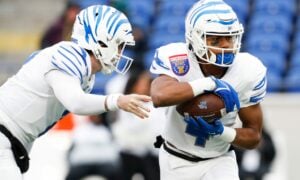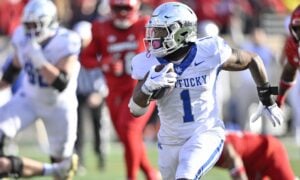Dissecting Dynasty Startup Strategies
We’ve had a heck of an off-season in the dynasty community. Our sector of fantasy football continues to grow and strategy is constantly evolving. As a result, there is a need to assess how teams are constructed at the starting point to gauge owner intentions.
Thanks to Ryan McDowell’s monthly DLF ADP data, we have a large sample of potential teams. For this exercise, my focus will be on the first eight months of 2016 (January to August) across every mock and team, totaling 576 teams mock drafted. With all this data, we can see which strategies were used most and least this off-season while also looking for any other patterns that were consistent.
To start, we should define the strategies we will dissect and the parameters the teams were given to measure if it was used.
Late Round Quarterback – The idea of waiting on a quarterback until later in the draft. Here, we will define it as any team who waited until after the tenth round to draft their first signal caller.
Zero Running Back – The focus is on other positions given the uncertainty annually of running back contributions. In this exercise, any team which fails to draft a running back in the first five rounds qualifies.
Robust Running Back – The anti-zero running back strategy. Any team who drafts multiple running backs in the first five rounds is captured here.
Early Wide Receiver – Loading up on wide receiver early is the presumed dynasty strategy. Any team who selected at least four wide receivers in their first five selections makes the grade.
Late Tight End – Similar to the quarterback strategy, a team will wait until late in the draft to fill the position. Just like late round quarterback, teams who are without a tight end after ten rounds is using this strategy.
Now, here are the results and analysis by strategy.

Late Round Quarterback – Unsurprisingly, this is one of the more popular strategies with a 35.4% probability (4.25/12) that a team will employ it. In all 48 mock drafts, at least two teams went this route with one mock draft seeing eight teams exploit the Late Round Quarterback theorem.
[am4show have=’g1;’ guest_error=’sub_message’ user_error=’sub_message’ ]
Zero Running Back – This was a shocker to me as I expected Zero RB to be more popular in the dynasty community. At just a 26.0% probability of usage, it is the lowest among the strategies I measured. No more than five teams in a mock draft used the strategy and there were three instances where only one team went this route.
Robust Running Back – Again, color me astonished on this one. At 35.2% probability, one more team on average is preferring Robust RB to Zero RB in dynasty. In one of every six mock drafts, at least half the league would use this strategy.
Early Wide Receiver – Finally, something that makes sense. This is the most popular strategy, at 40.5% probability, with two mock drafts seeing over half the league using this option. There were six mock drafts where “only” three teams employed this method.
Late Round Tight End – This is not a very popular strategy in dynasty drafts. There was only a 28.6% probability using this strategy with several mocks seeing just one team wait until after the tenth round for their first tight end. Just one draft featured half the teams (six) using this approach.
Crossover
Most of these strategies are not mutually exclusive, with the exception of Zero Running Back or Early Wide Receiver along with Robust Running Back – that means the possibility of using more than one strategy exists and owners are not beholden to just one option. As a result, the mix and match potential makes roster construction even more imaginative.
Looking at the number of strategies used by each team below, it’s clear teams are not afraid to engage more than one – 57% of teams (roughly seven per 12 team mock draft), are using at least two of these five strategies. On the flip side, 13% or 1.5 teams, do not subscribe to any of these options.
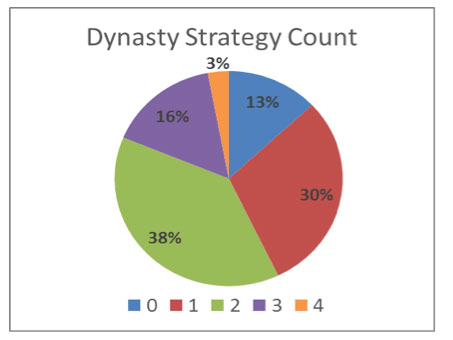
If we dissect further, we can see which pairings are the most prevalent among dynasty drafters. Looking below, it is clear that owners who focus on an early position (particularly early WR) will in turn punt another. Most commonly, it is the running back position sacrificed early for wide receiver, partially due to the measuring parameters of the first five rounds. However, late quarterback and tight end are also popular with the early wide receiver strategy.

Since Early Wide Receiver is the most popular strategy (and the most popular to pair with another), it is worth looking into how interwoven it is with other strategies a bit more. When comparing instances of multiple strategies employed with Early Wide Receiver, it is Quarterback and Running Back most frequently ignored in favor of them. Foregoing tight end seems to be less popular with Early Wide Receiver advocates, meaning they focus on both receiving positions early.
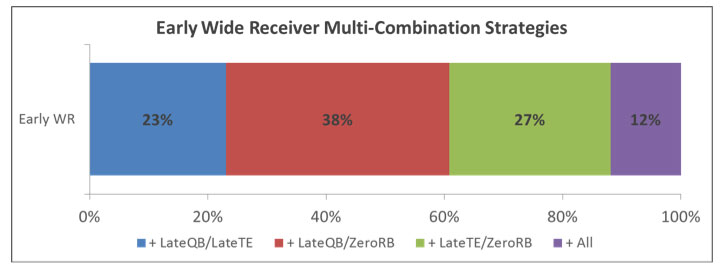
What’s My Age Again?
The other component beyond positional strategy is that of age. I would not go so far as to say that drafting younger is a “win later” approach since there are plenty of nascent players who are contributing today (see: Beckham Jr., Odell). That said, there are owners who are mindful of player age as they go through a draft. Below takes a look at the average age of all 576 mock draft teams’ first ten selections.
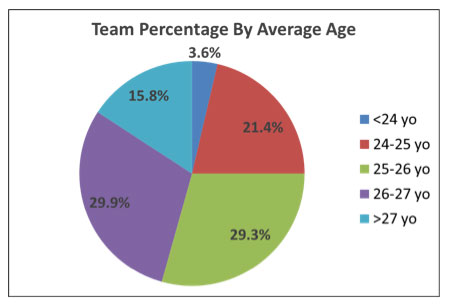
Unsurprisingly, it is a bell curve style set of results as the oldest and youngest brackets have the lowest rate of usage. Among the mock drafts, there were three where no team averaged 27 or older among their first ten draft picks. Conversely, three mock drafts had no teams aged 27 or older on average. Whereas, the youngest bracket was only represented by multiple teams (two in each instance) on three occasions.
The youngest team was just 23.1 years of age while the oldest was 29.4, giving a fairly wide range of average age ownership. That said, the average drafting age overall in the first ten rounds is fairly consistent, landing between 25.5 and 26.5 years old in all 72 mock drafts.
Telling the Future
I will (happily) admit I threw a lot of information onto the digital page. With so many teams to examine across mock drafts and various points of the offseason, we have only scratched the surface of what recent trends look like. Since we have all this past data, let’s try and predict the future, too!
Early Wide Receiver
Future Outlook: Moderate. I believe owners will continue to drive this strategy for several years while the 2014 class ages into that precarious abyss known as the late twenties. Eventually, another draft class will produce a handful of strong prospects, but that does not look imminent. While owners are continuing to value wide receivers highly, the talent is shifting to other positions in regards to prospects – that’s enough to give me doubt that it remains the preeminent strategy.
Late Round Quarterback
Future Outlook: Strong. This strategy looks like it will hold for a while. The college landscape appears light with potential quarterback options (although a few always surprise). Add in the fact that quarterbacks largely thrive well into their thirties and the aversion to age; we have a strategy which plays perfectly in dynasty. I would bet on this being a more popular strategy than Early Wide Receiver in the next three years.
Zero Running Back
Future Outlook: Low. You may be surprised to see this answer but with the crop of young NFL running backs and the talent influx from the 2017 and 2018 draft classes will keep this strategy under the radar. Currently, we see six running backs in the top 36 based on recent ADP (Mark Ingram just misses the mark). I suspect the number will easily surpass double digits by next year, similar to 2015, as owners gravitate towards rookie running backs and find several breakouts from the 2015 and 2016 classes. As a fan of this strategy, this would be a great outcome for me!
Robust Running Back
Future Outlook: Strong. Obviously, if the Zero Running Back strategy has a poor outlook, then the opposite strategy must look good for many of the same reasons. The incoming flux of talent along with some young runners maturing should help the depth at the position. This will only help dynasty owners as it allows for diversity in strategy going forward.
Late Tight End
Future Outlook: Moderate. The position currently boasts a litany of options at the top as well as bargain options later. With a strong 2017 class of tight ends expected (as many as four could be first round selections), the position should be replenished as the elite begin to show their age and the Jason Witten/Antonio Gates cohort fades away. As a result, we will continue to see a mixture of those securing elite options and others waiting on the next group of veteran choices.
In terms of age, there will always be owners who focus on youth as a primary input to their selections. Conversely, others will prioritize different factors higher and see age as a secondary characteristic. As such, the distribution of average age amongst teams will likely remain indefinitely.
While the future is unclear, this look at the past should give a baseline to where things are heading. Any of these strategies can work if executed under the pretense of winning championships. Comment below with any thoughts, questions, or strategies you tried this off-season.
[/am4show]
- Bowl Game Previews: CFB Playoff Semifinals - December 28, 2018
- The Narrative Fallacy and How it Compels Us - May 13, 2017
- 2017 NFL Draft – College Wide Receiver AIR - April 27, 2017






